#systemunit
Explore tagged Tumblr posts
Text
Price: [price_with_discount] (as of [price_update_date] - Details) [ad_1] BCS-011 IGNOU Help Book for BCA Computer Basics and PC Software Topic Covered Block 1 Basics of Computer Hardware Unit-1 Computer their Origin and Applications Unit-2 Functioning of a Computer Unit-3 Memory System Unit-4 Input Output Devices Unit-5 My Personal Computer Block 2 Basics of Computer Software Unit-1 Software Evolution Unit-2 Operating System Unit-3 Concept in Programming Language Unit-4 Computer Applications Block 3 Internet Technologies Unit-1 Networking and Internet Unit-2 Web Applications-I Unit-3 Web Applications-II Total Question Papers (Total-14, Solved-4, Unsolved-10) June 2013 December 2013 June 2014 December 2014 June 2015 December 2015 June 2016 December 2016 June 2017 December 2017 June 2018 December 2018 June 2019 December 2019 GullyBaba IGNOU Help books or Guides are the best resources for quality solved papers, ten years, guess papers, notes, and previous year papers' solutions. Lakhs of students from more than 15 years have witnessed that these books are the reason for Good Marks in less than 11 days...even if You're busy in your job or business! IGNOU Students are saving a lot of time and money that they were spending searching Solved Previous Years' Papers, Solved Important Questions, Exam Notes, and much more... All these are available in a single book. Features of Gullybaba IGNOU Help Books: Can even adjust in handbags easily and can be taken anywhere along with you. Easy to read while traveling. Contains the highest number of previous solved papers among all ignou help book publishers in the world. It comes with exam notes, and exam preparation starts from the very beginning. Chapter summary and fully matched syllabus make it a boon for IGNOU students. What else you need! For lakhs of 1st year, 2nd-year students, Help books are crucial in the examination. ASIN : B08Y92KHWP Publisher : Gullybaba Publishing House Pvt. Ltd. (7 March 2021) Language : English File size : 11494 KB Text-to-Speech : Not enabled Enhanced typesetting : Not Enabled X-Ray : Not Enabled Word Wise : Not Enabled [ad_2]
0 notes
Text
^DOWNLOAD P.D.F.# Dosage Calculations for Nursing Students Master Dosage Calculations The Safe & Easy Way Without Formulas! [READ]
^DOWNLOAD P.D.F.# Dosage Calculations for Nursing Students: Master Dosage Calculations The Safe & Easy Way Without Formulas! [READ]
Dosage Calculations for Nursing Students: Master Dosage Calculations The Safe & Easy Way Without Formulas!

[PDF] Download Dosage Calculations for Nursing Students: Master Dosage Calculations The Safe & Easy Way Without Formulas! Ebook | READ ONLINE
Author : Chase Hassen Publisher : Independently Published ISBN : 1096128748 Publication Date : 2019-5-11 Language : Pages : 220
To Download or Read this book, click link below:
http://read.ebookcollection.space/?book=1096128748
??Download EBOoK@?
Synopsis : ^DOWNLOAD P.D.F.# Dosage Calculations for Nursing Students: Master Dosage Calculations The Safe & Easy Way Without Formulas! [READ]
Welcome to the second edition of our dosage calculations book!Are you a nursing student, or nurse, who wants to learn a few simple methods of solving dosagecalculations without a bunch of formulas?Would you like to raise your hand in your dosage calculation class, after the instructor explains acomplicated formula, and ask to approach the white board to show the class a much simpler method?Do you want to go on your clinicals knowing that you have a solid foundation in dosage calculations?Do you want to walk into your Nursing Calculations Class on the first day knowing that you can ace allthe tests before the course begins?If you answered yes to any of these questions, this book is for you!The book is divided into seven units containing thirty-five chapters.Unit 1: Essential Skills: You can't learn to drive a car if you don't understand the function of the steering wheel. The same applies to the following subjects when learning dosage calculations.The Metric SystemApothecary/Avoirdupois/Household SystemsRatiosDimensional Analysis (DA) and Ratio Proportion (RP)Rounding NumbersMilitary TimeUnit 2: Auxiliary Subjects: Roman NumeralsScientific NotationUnit 3: Unit ConversionsUnit 3 covers converting between and within the various systems of measurement using dimensional analysis and ratio proportion.Unit conversions Within the Metric SystemUnit Conversions Within the Household SystemUnit Conversions Between Metric, Household and Apothecary SystemsUnit Conversions Involving Pounds and OuncesUnit Conversions Involving Hours and MinutesUnit 4: Dosage CalculationsUnit 4 builds on the knowledge gained in the previous units and covers dosage calculations, starting with the terminology and set up of problems, then progressing from easy, one-step, problems through multi-step problems.Dosage Calculations-The BasicsDosage Calculations Levels 1-3Body Surface Area Dosing CalculationsPediatric Dosage CalculationsPediatric Maintenance Fluid Replacement CalculationsUnit 5: IV Flow Rate CalculationsUnit 5 starts with the basic terminology and set up of IV flow rate problems, then moves on to:Simple and Advanced ProblemsIV Flow Rate Adjustment CalculationsHeparin Infusion and Adjustment CalculationsUnit 6: Percent and Ratio Strength CalculationsPercent,Percent StrengthPercent ChangeRatio StrengthUnit 7: Miscellaneous SubjectsReconstitution CalculationsConcentrations and DilutionsMilliequivalent CalculationsDosage Calculations PuzzlesSelf-Assessment ExamThe book contains over 600 high quality practice problems with answers. We look forward to your feedback!Chase Hassen and Brad Wojcik
0 notes
Link
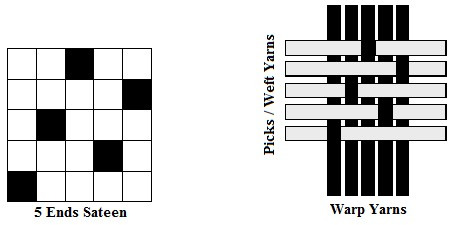
What is Weaving?
Weaving is a process of making fabric with two separate sets of yarns called the Warp and the Weft. The Warp yarns in the form of sheet (called warp sheet) are wrapped on the beam and runs the length of the fabric. The Weft yarn is entirely separate yarn than the Warp yarns and it is laid between two layers / sheets of the Warp yarns (called Shed) across the width of the fabric. A new shed is then formed in accordance with the desired weave structure, with some or all of the ends in each sheet moving over to the position previously occupied by the other sheet. In this way the Weft is gripped between two layers of the Warps. Here one Warp yarn is called an End and one Weft yarn is called a Pick.
How is the industrial revolution happened in Weaving?
There was a significant development in 1733 when John Kay (Born in Lancashire, England) developed and patented the “Flying Shuttle” with metal capped ends, wheels and a pirn of weft thread for the hand loom.
Then Edmund Cartwright (Born in Nottinghamshire, England) designed his first power loom in 1784 and patented it in 1785, but it proved to be valueless. In 1789, he patented another loom which served as a model for later inventors to work upon.
What are Primary and Secondary Motions in Weaving process?
The weaving process consists of 3 basic / primary motions: Shedding, Picking & Beat-up.
Shedding: Separating the Warp yarns into 2 layers by lifting and lowering the shafts, to form a tunnel is called the Shed. See the Shedding in below mentioned figure A:
Picking: Passing the Weft yarn (Pick) across the Warp threads through the shed is called Picking. See the Picking in below mentioned figure B:
Beat-up: Pushing the newly inserted Weft yarn (Pick) into the already woven fabric (at fell of the cloth) using the Reed is called Beat-up. See the Beat-up in below mentioned figure C:

The weaving process consists of 2 secondary motions: Let-off & Take up.
Let-off: This motion delivers Warp yarns to the weaving area at the required rate and at a constant tension by unwinding it from a flanged tube known as the weaver’s beam or warp beam.
Take up: This motion draws the woven fabric from the weaving area at a constant rate (this rate is depending upon required PPI) then winds it onto a cloth roller.
Which are essential Auxiliary functions in Weaving process?
Mainly 2 Auxiliary functions are required for the weaving: Warp Stop Motion & Weft Stop Motion.
Warp Stop Motion: This mechanism is responsible to stop the loom when a Warp yarn breaks or excessively loose.
Weft Stop Motion: This mechanism is responsible to stop the loom when a Weft yarn breaks or the Weft runs off the Weft Package.
What is general Weaving diagram?
A general sketch of threads and woven fabric’s flow on the loom is shown in the below figures:
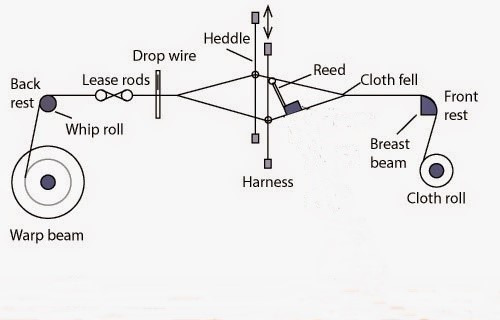
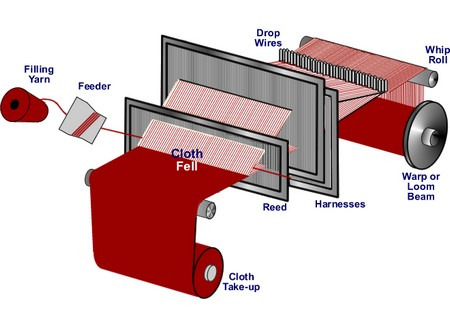
What is Yarn Count?
Yarn Count is a numerical value, which express the diameter (Coarseness or Fineness) of the yarn and also indicates relationship between length and weight (the mass per unit length or the length per unit mass) of that yarn.
There are two types of Yarn Count Systems: Direct Count System & Indirect Count System.
Direct Count System: Here, the length is fixed. The weight per unit length is the Yarn Count. All Direct Count Systems are having fixed length of the yarn and weight of the yarn varies according to its diameter.
Numbering SystemUnit of Length (I)Unit of Weight (W)
Tex (T)1000 metersNo. of Grams
Denier (D)9000 metersNo. of Grams
Deci Tex (dtex)10000 metersNo. of Grams
Jute Count14400 yardsNo. of Pounds (lb)
i.e., 40 Tex of filament yarn means 1000 meters of yarn weigh 40 grams.
Indirect Count System: Here, the weight is fixed. The length per unit weight is the Yarn Count.All Indirect Count Systems are having fixed weight of the yarn and length of the yarn (in form of Hanks / Coils) varies according to its diameter.
Numbering SystemUnit of Length (I)Unit of Weight (W)
English Cotton Count (Ne)840 yards1 Pound (lb)
Metric Count (Nm)1000 meters1 kg
Woolen Count (YSW)256 yards1 Pound (lb)
Jute Count14400 yardsNo. of Pounds
Which are regular or basic weaves?
Regular / Basic weaves give even and easily identified appearance to the woven fabric. Some of the commonly used regular weaves are as below:
1/1 Plain: Plain weave is the most commonly used weave in the weaving industry.
The principle involved in the construction of plain cloth is the interlacement of any two continuous threads either warp or weft in an exactly contrary manner to each other, with every thread in each series passing alternately under and over consecutive threads of other series interlaces uniformly throughout the fabric. By this plan of interlacement, every thread in each series interlaces with every thread in the other series to the maximum extent, thereby producing a comparatively firm and strong texture of cloth.
Set of the Warp Yarns, skipping one warp yarn alternatively, making up and down movement one by one creates a shed and this is what being done in plain weave. It means 50 % of total Warp Yarns remains up and rest of 50 % of them remains down always.
A complete unit of the plain weave occupies only two ends of warp yarns and two picks of weft yarns.
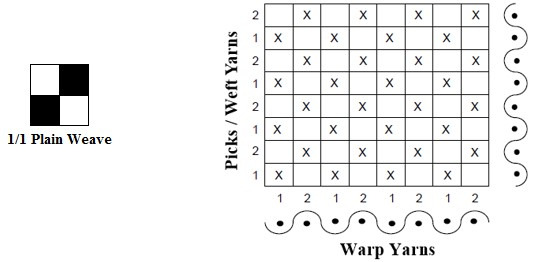
2/2 Matt: In case of regular matt weave, the plain weave is extended equally in the warp and weft directions in bunch of 2 or 3 or 4 warp and weft yarns.
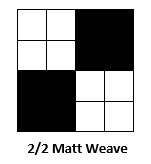

Twill Weave: Twill weave is done by passing the weft yarn under the 2 or more warp yarns and then over the one warp yarn and so on. Twill weave distinguishes from other weaves is because of the presence of visible diagonal lines that run across the width of the woven fabric.
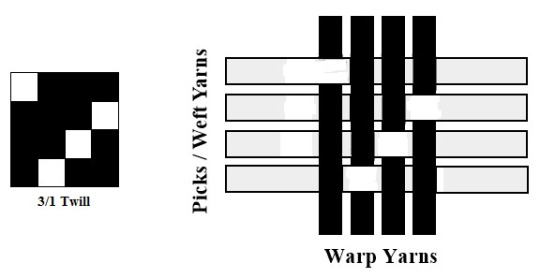
Satin and Sateen Weaves: Satin is the Warp faced rearranged twill and Sateen is the Weft faced rearranged twill. Thus satin is the reverse side of the Sateen weave. The highlighted feature of these weaves are their brightness / lustrous appearance and smoothness.

Which loom / machine is suitable for weaving basic weave / weaves?
For weaving different kind of Regular / Basic weaves, loom / machine must be equipped with at least separate Cam Shedding mechanism with minimum 7 heald frames accommodation.
With above loom specifications, weavers can able to weave a fabric with basic weaves like 1/1 Plain Weave, 2/2 Matt Weave, 2/1 Twill Weave, 3/1 Twill Weave, 3/1 Broken Twill Weave, 1/3 Twill Weave, 1/3 Broken Twill Weave, 2/2 Twill Weave, 4/1 Twill Weave, 5 Ends Satin, 5 Ends Sateen, Combination of 1/1 & 2/2 Weave, Combination of 1/1 & 3/1 Weave, Combination of 2/1 & 1/1 Weave, Combination of 5 Ends Satin & 1/1, Combination of 5 Ends Satin & 2/2, Combination of 5 Ends Sateen & 1/1, Combination of 5 Ends Sateen & 2/2, etc.
Is it possible to produce the fabrics with basic weaves with the help of Tappet Shedding similar to that of Shuttle loom? If not, why?
It is not possible to run different kinds of basic weaves with the help of Tappet Shedding similar to that of Shuttle loom.
Mainly there are two reasons clarifying this ‘NO’:
(1) Not possible to accommodate more than 4 heald frames with Shuttle loom type Tappet Shedding. Where as many of weaves and combination of weaves need 5 or 6 or 7 heald frames at least.
(2) This kind of traditional Tappet Shedding have fixed cam shedding mechanism, means there is fixed drive / fixed rotation ratio to Tappet motion from loom and hence not possible to run different kind of basic weaves.
For making fabric of many weaves and combination of weaves, one must have weaving machine equipped with separate cam shedding mechanism in which weavers can achieve different basic weaves by just replacing concerned cams.
#weaving machine manufacturer in India#Textile Machinery Manufacturers#Textile Machinery Spare Part Manufacturers#Shuttle Loom Manufacturers#Textile Machinery Part Dealers#Textile Machinery Spare Part Dealers#Loom Manufacturers#Dobby Machine
0 notes
Text
systemunit replied to your post: IF ANYONE KNOWS WHAT A TWO STAGE HIERA...
is this for science??
statistics omg but yea i’ll just write two and pray 2 the lord jesus it is right
3 notes
·
View notes
Photo

Here is an exclusive link to the new video https://youtu.be/Gr9G44Hxm3w #vamose #backtobasicske #teameg #princecam #music #art #creative #performer #global #prisk #mcsk #groove #kubambaradio #kubamba #crossover #theswitch #jccircle #jcckenya #church #gospel #system #beauty #systemunit #b2bconcepts #genius #geniusrepublic #nolimits #trending #recommended #gainpost #african #success #Rap #hiphop #Africaraps
#kubamba#hiphop#system#rap#creative#prisk#african#theswitch#jcckenya#systemunit#global#groove#art#kubambaradio#recommended#gainpost#crossover#mcsk#teameg#vamose#gospel#jccircle#genius#princecam#africaraps#beauty#b2bconcepts#backtobasicske#success#performer
0 notes
Text
Price: [price_with_discount] (as of [price_update_date] - Details) [ad_1] BCS-011 Computer Basics and PC Software (Edition 2018) CONTENTS COVERED Block- 1 Basics of Computer hardware Unit-1 Computer their Origin and Applications 1 Unit-2 Functioning of a Computer Unit-3 Memory System Unit-4 Input Output Devices Unit-5 My Personal Computer Block- 2 Basics of Computer Software Unit-1 Software Evolution Unit-2 Operating System Unit-3 Concept in Programming Language Unit-4 Computer Applications Block- 3 Internet Technologies Unit-1 Networking and Internet Unit-2 Web Applications-I Unit-3 Web Applications-II SAMPLE PAPERS Sample Paper-I Sample Paper-II TOTAL QUESTION PAPERS (Total-11, Solved-4, Unsolved-7) June 2013 December 2013 June 2014 December 2014 June 2015 December 2015 June 2016 December 2016 June 2017 December 2017 June 2018 Publisher : Gullybaba Publishing House (P) Ltd; 1st edition (1 January 2012) Language : English Paperback : 268 pages ISBN-10 : 9381638497 ISBN-13 : 978-9381638491 Item Weight : 360 g Dimensions : 8.5 x 5.5 x 0.37 cm Country of Origin : India [ad_2]
0 notes
Note
have you been on an aeroplane and if so did you like it?
nope, never been one one!
url: meh | not bad | i like it | i love it | purrrfecticon: not my type | not bad | i like it | i love it | purrrfecttheme: not my type | not bad | i like it | i love it | purrrfectposts: not my type | not bad | i like them | i love them | brb i have to reblog everythingoverall: not my type | not bad | i like it | i love it | purrrfectionfollowing?: no, sorry but ily ♥ | now i am | yes! | forever!
send me a question for a blograte! 9/15
1 note
·
View note
Note
27, 39!! 💖
27: Fears?
my future
boats
being alone
39: Do you have a crush?
nopedy nope~~
thanks!!
TMI TMI TMI!
1 note
·
View note